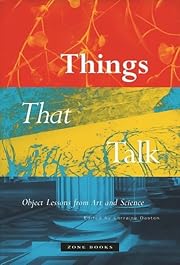|   - Primary page
- Work details
- Reviews (0)
- Recommendations
- Members
- Descriptions
- Common Knowledge
- Cover images
- Editions
| Loading... Things That Talk: Object Lessons from Art and Science by Lorraine Daston (Editor)
| 94 | None | 239,460 |  (iv.5) (iv.5) | None | Essays examine nine intriguing objects fabricated eloquent when affair and pregnant converge. Imagine a world without things. There would be zilch to describe, null to explicate, remark, interpret, or mutter about. Without things, nosotros would finish speaking; we would become as mute as things are alleged to be. In nine original essays, internationally renowned historians of fine art and of science seek to sympathise how objects become charged with significance without losing their gritty materiality. True to the particularity of things, each of the essays singles out 1 object for close attention: a Bosch drawing, the freestanding cavalcade, a Prussian island, soap bubbles, early photographs, glass flowers, Rorschach blots, newspaper clippings, paintings by Jackson Pollock. Each is revealed to exist a node around which meanings accrete thickly. But not just any meanings: what these things are fabricated of and how they are fabricated shape what they can mean. Neither the pure texts of semiotics nor the brute objects of positivism, these things are saturated with cultural significance. Things become talkative when they fuse matter and significant; they lapse into speechlessness when their matter and meanings no longer mesh. Each of the nine objects examined in this volume had its historical moment, when the match of this thing to that thought seemed irresistible. At these junctures, certain things go objects of fascination, association, and endless consideration; they brainstorm to talk. Things that talk fleetingly realize the dream of a perfect language, in which words and earth merge. Essays Lorraine Daston, Peter Galison, Anke te Heesen, Caroline A. Jones, Joseph Leo Koerner, Antoine Picon, Simon Schaffer, Joel Snyder, and M. Norton and Elaine Yard. Wise. Lorraine Daston is Director at the Max Planck Establish for the History of Science in Berlin, Frg. She is the coauthor of Wonders and the Society of Nature, 1150-1750 (Zone Books). … (more than) | ▾ LibraryThing Recommendations  ▾ Will you like it? Loading...  Sign up for LibraryThing to notice out whether you'll like this volume. ▾ Conversations (Almost links) No current Talk conversations nigh this book.  ▾ Published reviews ▾ Series and piece of work relationships | | | Canonical title | | | Original title | | | Alternative titles | | | Original publication date | | | People/Characters | | | Of import places | | | Important events | | | Related movies | | | Awards and honors | | | Epigraph | | | Dedication | | | First words | | | Quotations | | | Final words | | | Disambiguation discover | | | Publisher'south editors | | | Blurbers | | | Original language | | | Approved DDC/MDS | | | Approved LCC | | ▾ References References to this work on external resources.  Wikipedia in English (1) Wikipedia in English (1) ▾ Book descriptions Essays examine nine intriguing objects made eloquent when affair and meaning converge. Imagine a world without things. There would be nothing to draw, null to explain, remark, interpret, or complain about. Without things, we would stop speaking; nosotros would become every bit mute as things are declared to be. In nine original essays, internationally renowned historians of art and of science seek to understand how objects become charged with significance without losing their gritty materiality. True to the particularity of things, each of the essays singles out one object for close attending: a Bosch drawing, the freestanding column, a Prussian isle, soap bubbles, early on photographs, glass flowers, Rorschach blots, paper clippings, paintings by Jackson Pollock. Each is revealed to be a node around which meanings accrete thickly. But not just whatever meanings: what these things are made of and how they are fabricated shape what they can hateful. Neither the pure texts of semiotics nor the brute objects of positivism, these things are saturated with cultural significance. Things become talkative when they fuse matter and meaning; they lapse into speechlessness when their affair and meanings no longer mesh. Each of the ix objects examined in this volume had its historical moment, when the match of this thing to that thought seemed irresistible. At these junctures, certain things become objects of fascination, clan, and endless consideration; they begin to talk. Things that talk fleetingly realize the dream of a perfect linguistic communication, in which words and earth merge. Essays Lorraine Daston, Peter Galison, Anke te Heesen, Caroline A. Jones, Joseph Leo Koerner, Antoine Picon, Simon Schaffer, Joel Snyder, and K. Norton and Elaine M. Wise. Lorraine Daston is Director at the Max Planck Institute for the History of Science in Berlin, Deutschland. She is the coauthor of Wonders and the Order of Nature, 1150-1750 (Zone Books). ▾ Library descriptions No library descriptions found.  ▾ LibraryThing members' clarification | Popular covers  Google Books — Loading... Google Books — Loading... |


 (iv.5)
(iv.5) 


![]()

 Wikipedia in English (1)
Wikipedia in English (1) Google Books — Loading...
Google Books — Loading... 
0 Response to "Things That Talk Object Lessons From Art and Science Doi"
Post a Comment